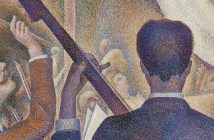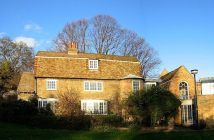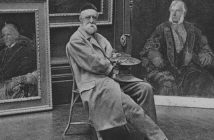Early Autumn in London and I find myself, having strayed off the beaten track, in Manchester Square quietly tucked away somewhere between bustling Oxford Street and Marylebone High Street. Not strictly a square – but does it matter – it gives the appearance of one with its central trees and gardens, while all around are prestigious-looking Georgian townhouses and mansions of some 4 or 5 storeys.
Early leaf fall has carpeted the ground with an explosion of colours, and a light breeze orchestrates an ever-changing display. I am heading for a large Italianate mansion within these quiet, leafy environs. Built in the late 1700s, Hertford House was previously home to the Spanish and the French Embassies, before being acquired by the Marquis of Hertford – just one of his many abodes. These days it’s perhaps not known as one of London’s principal art galleries but certainly contains no less than one of the world’s finest private collections of art. Famed travel writer H V Morton described it as a ‘little Louvre’ where “there is probably in the world no more surprising display of the acquisitive abilities of a few wealthy and cultivated aristocrats”. I feel quite safe in quoting Morton’s words, despite being some 60-odd years old, as the collection’s bequeathal to the nation in 1897 was firmly anchored on the condition that it would go on permanent public display and that nothing should be added or taken away. What admirable foresight, I thought, for if one is to tamper with a private collection, by adding or subtracting objects, the very concept of a personal collection is lost forever.

The collection was amassed by four generations of the Marquises of Hertford between 1760 and 1880. As you can imagine, that’s some phenomenal coverage of perhaps one of the greatest eras and outputs in art history and, needless to say, it encompasses a magnificent display of Italian, Spanish, Flemish, English and French paintings, as well as furniture, ceramics, clocks, armour, bronzes, marbles and porcelain. According to Morton, the fourth Lord Hertford, who added to the collection he had inherited from his father, lived in Paris and had no interest in people or society – he yearned only to find and purchase beautiful things. This he surely achieved and, when he died in 1870, it was widely regarded that he owned the most incomparable private collection of art treasures in the world.
His son, Sir Richard Wallace, was not only bequeathed the collection but appears to have inherited his father’s reclusive and acquisitional nature, too. Richard moved the collection he had gathered in Paris to London and to Hertford House which had stood empty for 35 years, although happily maintained by a succession of retainers. Many works of art were already here and, thus, Wallace was greeted by the stirring sight of paintings by Rubens, Reynolds, Gainsborough, Canaletto and Titian on the walls of the drawing rooms and staircases. He continued to add to the collection started by his father and grandfather whilst living a quiet life in Manchester Square. He died in 1890 leaving the collection to his French wife who, on her death left it to the nation. The museum here opened in 1900.
 Today, in Hertford House, there are 25 galleries to wander around and just savour these priceless works of art. Rembrandt’s Titus and The Artist’s Son, Titian’s Perseus and Andromeda, Franz Hals’s Laughing Cavalier, paintings and ceramics from the Italian and Spanish schools, from Guardi, Velazquez, Avelli. Unsurprisingly, given the family’s connections to Paris, French art predominates and there is an absolute treasure trove of 18th century paintings, sculpture and decorative arts. Fragonard’s The Swing, Watteau’s Champs Elysees, and then Boucher’s more earthy depictions of naked nymphs and goddesses (“edible rosy beauties” as Morton described them) all prime examples of the Rococo period. Perhaps Boucher’s painting of Madame de Pompadour – his patroness – is amongst the most famous, and she had her clothes on! Painted, on her request, for her lover King Louis XV in the hopes of regaining his interest, which was on the wane. Then there are the wonderfully French pastoral scenes by Lancret – evoking thoughts of aristocratic life in the countryside, before the French Revolution destroyed it all.
Today, in Hertford House, there are 25 galleries to wander around and just savour these priceless works of art. Rembrandt’s Titus and The Artist’s Son, Titian’s Perseus and Andromeda, Franz Hals’s Laughing Cavalier, paintings and ceramics from the Italian and Spanish schools, from Guardi, Velazquez, Avelli. Unsurprisingly, given the family’s connections to Paris, French art predominates and there is an absolute treasure trove of 18th century paintings, sculpture and decorative arts. Fragonard’s The Swing, Watteau’s Champs Elysees, and then Boucher’s more earthy depictions of naked nymphs and goddesses (“edible rosy beauties” as Morton described them) all prime examples of the Rococo period. Perhaps Boucher’s painting of Madame de Pompadour – his patroness – is amongst the most famous, and she had her clothes on! Painted, on her request, for her lover King Louis XV in the hopes of regaining his interest, which was on the wane. Then there are the wonderfully French pastoral scenes by Lancret – evoking thoughts of aristocratic life in the countryside, before the French Revolution destroyed it all.
One comes away from the Wallace Collection with an overwhelming sense of Eighteenth Century France – its culture, artists and history, although all that is there is a treasure. Everything in the collection has demonstrated a succession of family members, in the Marquises, keen to possess such works of art. I can’t decide if it was a matter of good taste, or just a desire (by the rich and idle, dare I say?) to own and add to a private collection. Now that they are gone and have left these wonderful things to the nation, I suppose it doesn’t really matter. Acquisition and possession has turned into philanthropism – what a wonderful legacy to leave behind for a larger public to appreciate.
Emerging into a now damp Manchester Square I find that light rain has plastered the red, green and gold hued leaves to the pavements, and making walking somewhat precarious. I’m not looking down however but, rather, into the squally skies above, my mind filled with the wonders of the art and history that I discovered here today.
The Wallace Collection, Hertford House, Manchester Square, London W1U 3BN. Telephone +44 (0)207 563 9500.
The gallery is open 7 days a week, 10am-5pm. Admission is free. For more information, including a video of the director introducing the collection and their Top Ten Things To Do to get the most out of your visit, go to www.wallacecollection.org.
All images courtesy and (c) The Wallace Collection.




